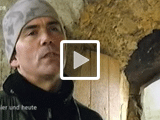 |
       |  |
zurück zur Übersicht
|
Frankfurter Allgemeine May 19th, 2006 A Mixture of the Strange and the Trivial By Christian Geyer It's a government agency, it's a government agency! Gone is whole mythology. An intelligence service's precinct where photographs may be taken has substantially surrendered its symbolic capital. This is a fact, whatever may now be revealed that is strange (see the tiled »Erstversorgungsraum« [primary care room], where the observing imagination oscillates between a chamber for disinfection or torture) or trivial (basically see the rest of the images). Photographic artist Andreas Magdanz was allowed into the premises of the BND in Pullach to take pictures, under permanent supervision, of all he could see through his lens; not, however, of people. The images, which are devoid of human beings, were collected in the book »BND - Standort Pullach«, which has just been published by DuMont. Only Kafka could have described more strikingly, with a more leaden atmosphere, what the word »unease« could mean. The Transparent Spook Principle Mr Magdanz sent his request to the BND at the end of 2003. In August of 2005, he was premitted entry into the property of the Bundesnachrichtendienst for the first time. What calculated agenda may the BND have with regard to its public image? We don't know, and shall never know. The artist was given a free rein, we read. Perhaps the reason for the sudden transparent spook principle is only the intention of being able to stick a few professional pictures of Good Old Pullach in the services' albums before most BND personnel relocates to Berlin. Andreas Magdanz is no stranger to taking photographs of symbolically charged sites. His projects include the former government bunker of the Federal Republic of Germany, as well as the concentration camp Auschwitz-Birkenau. What an insight into desolation after all those years of hiding under a false name. Just a reminder: for decades, the hermetically sealed BND site was officially identified as part of the »Bundesvermögensverwaltung, Abteilung Sondervermögen, Aussenstelle Pullach« (Federal Property Administration, Department of Special Assets, Pullach branch). The neighbours were to think that hundreds of gardeners, beekeepers and revenue officers were working behind the four-kilometre ring of walls and fences of steel. It was the time of the Cold War, and the foreign intelligence service still knew its purpose. With cameras hidden in ties, they had their hands full making snapshots of suspicious Soviets, and had absolutely no time to have their offices photographed by photo artists. Today, since the working pressure has let up in the relationship between East and West, and even seems to disappear completely, (photographic) art has better chances in Pullach. Hidden Track into the Heart of Darkness Because we now know better, thanks to Andreas Magdanz, the myth of this upright institution, which dates back to the days of the foundation of the Federal Republic of Germany, is reduced to office and communication gear, numbered huts, staircases, desks, bunker passages, folders, in short: to just another planning concept. What in the photograph looks like an emergency exit from history, like post-conciliar confessionals, is only a hidden track into the heart of darkness. It's the armoured cabinets of the IBM computers, where no history ever gets lost, even if it remains without import. The artist makes history's footprints visible even where Pullach appears to be a tantalisingly unhistorical place. Indeed, the functional appearance of the Pullach complex has undergone manifold metamorphoses over time. Before the secret Gehlen organisation, the former department »Fremde Heere Ost« in the Wehrmacht's high command, moved here in 1947, the Pullach site had been used as »Reichssiedlung Rudolf Hess« and as the »Führerhauptquartier Siegfried« during the Nazi era. Just a Stone's Throw away from »Old Fritz« For the young democracy's agents, this was an ideal place not only for contemplating, in strict isolation, the course the world was taking, but also to be self-sufficient with their families. Here, they could live and work in secrecy, undisturbed, in a town within a town, so to speak, with its own kindergarten, its own school, other social facilities and, lest one forget, its own way of thinking. Thus, the BND site presents itself as a surreal collage of Reichsarbeitsdienst huts and administrative blocks from the seventies. The synchronicity of the asynchronous as a way of life that can be pursued at one's desk. Especially, of course, at those desks that have a free view of the various clocks showing the time zones around the globe. With a clear view of the time, the usual questions of the job can be answered in relation to the global scale: BND watchman, what of the night? When does the CIA colleague's plane touch down? The office containing the world clock is only a stone's throw away from the oil painting of Old Fritz from the former Villa of Martin Bormann. Today, the painting can be seen as a representative backdrop of power in one of those training auditoriums where the agents-to-be learn how to behave in a Baghdad kidnapping, or how the latest order from the Chancellery, namely to leave the journalists alone from now on, is to be interpreted. That the increasingly exposed service dreams of more sovereign, that is, more secretive times, that a dream can actually blossom behind the walls of Pullach, a flaking and battered dream perhaps, a dream that is threatened by Pullach's impending vacancy, but a dream nonetheless - for this, the oil painting of the Prussian potentate may also be a sign from history. |
|||||||||||||||||||||
| aktuelles andreas magdanz arbeiten neue projekte magbooks presse lehre kontakt impressum | english | ||

